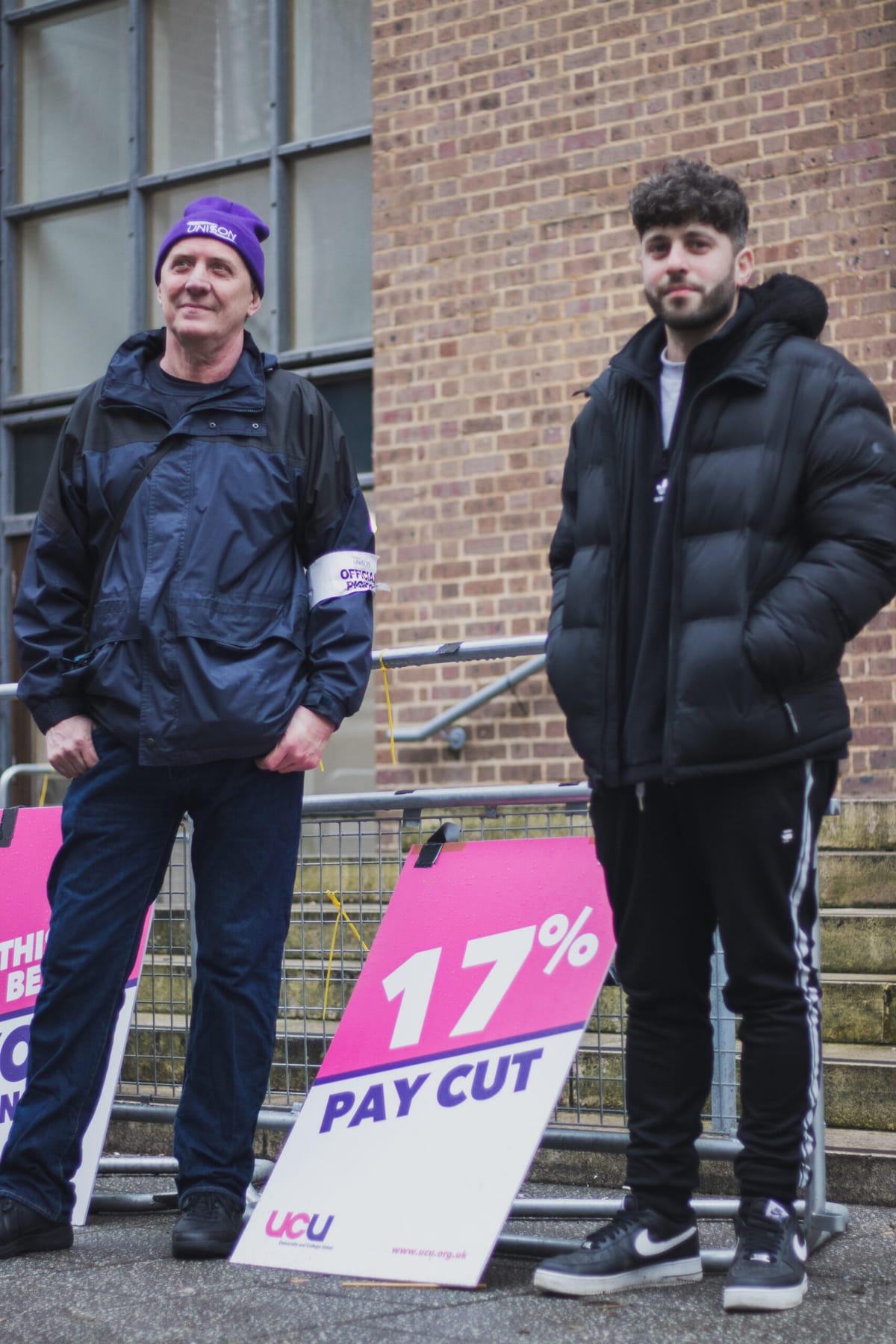Patrons of the Picket: A Conversation with Sandy Nicoll and Kerem Nişancıoğlu

By Millie Weighton Glaister, BA Politics and International Relations
Poetically, my interview with Sandy Nicoll and Kerem Nişancıoğlu was almost entirely jeopardised by London unravelling at the hands of a tube strike. Luckily, after a couple of electric bikes and a lot of swerving through gridlocked traffic, I made it out to the joint UCU and UNISON picket at SOAS; drenched and tired from an unexpectedly athletic commute, but excited nonetheless to speak with a couple of the faces of SOAS’ unions.
Before I saw the picket, I heard it. Music was blasting from massive speakers outside the main building, providing a positive attitude I had almost abandoned at the sight of a miserable March day in London. Barrelling around the corner, I started sifting through a crowd of familiar faces – patrons of the picket, students and staff alike. I spotted Sandy and Kerem on the furthest picket, perched outside the entrance to the Paul Webley wing. It came as no surprise to me; they would have been there for hours before I arrived, and likely would remain hours after I’d retreated from the cold.
‘Ready for a chat?’ I chirped, approaching a grinning Sandy opposite a rather more hesitant Kerem. As we gathered under the imposing architecture of Senate House, we eased into some simple introductions, with Sandy taking the lead: ‘My name is Sandy Nicoll, I’m the Unison Branch Secretary at SOAS. I work as an administrator in the IT department, I have worked at SOAS since 1994 so that makes me… quite old.’ Laughing, Kerem took over, quipping that they had recently been mistaken for father and son: ‘My name is Kerem Nişancıoğlu. I’m a senior lecturer in international relations, in the politics department. I’m also the UCU branch chair at SOAS.’
“In the context of the ongoing strikes, it has recently become obvious that many students at SOAS are encountering trade unions for the first time;”
In the context of the ongoing strikes, it has recently become obvious that many students at SOAS are encountering trade unions for the first time; we ventured into how they both became involved, and when that started. Sandy regaled the instance of returning from his first day of working at a supermarket aged 14: ‘the first question my mum asked me is what union I had joined.’ We shared a laugh as he continued, stating that at the time that was ‘deemed to be the normal thing,’ while now ‘there are generations that come through without the same awareness of what Unions are for and without the same consciousness about why taking that kind of collective action together is important.’
While Sandy seemed used to this kind of question, reassuring me that this was a story he’d told many times, Kerem was more reserved, taking his time to formulate a response, drawing on the indirect exposure to politics and trade unions he had growing up. Moving on to his ascent into his role as UCU branch chair, he claims it was unintentional, stating a large reason was that ‘no one else would do it.’ He laughed it off but it didn’t surprise me; from all my interactions on the picket, the role is no small feat. Even putting aside the direct antagonism of management, it’s a massive commitment and has incredibly high stakes – people’s futures for one.
Both Sandy and Kerem’s passion for being able to provide support to the people around them was as evident in their faces as in their words. Sandy remarked that the day the cleaners were officially brought in the house was one of the happiest days of his life. Kerem added that despite the ‘dispiriting and alienating’ realities of a heavily marketised institution, in his role he had been able to ‘connect with colleagues in a way that sort of recovers a genuine human relationship, that isn’t reducible to producing money.’
Having observed the power of a picket line over my time at SOAS, and having all those feelings intensified by my conversations with Sandy and Kerem, I was truly feeling the essence of what union action is about. Disappointingly, I know that doesn’t always translate to the rest of the SOAS community. So I passed that question over to them: how can we bridge the gap between staff and students in union and striking solidarity? They both arrived at the lack of and therefore the necessity for an educational program for students. Not simply in learning how to display solidarity with current union members, but actually in the use of unions in our futures. Sandy’s fear for current and future students was palpable; the realities of the world we are graduating into is not easy to reckon with. However, that just further increases the urgent need for young people to be armed with the power of collective action.
My final question was probably more for my benefit, rather than for the sake of the article. As an already jaded 20-something year old, I sheepishly asked if they still genuinely had faith in being able to change the institution. Their answers grounded me. Wins are possible; they have and will continue to happen. But rightfully, they both highlighted the scope of the necessary changes and how that speaks to the wider political landscape. The tools honed through collective action don’t have to be limited to the idea of what the institution is now or how it was in the past; there is room for an entire reimagination of what could serve every potential member of the community, and it is up to us to demand that.
Photo caption: Sandy Nicoll (left) and Kerem Nişancıoğlu (right) on the picket outside Brunei Gallery (Credit: Zo Wu).



